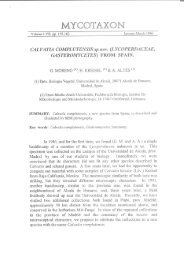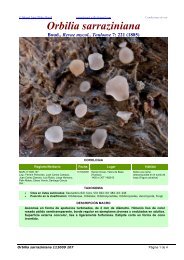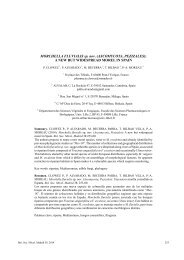Ramalina carminae (Ascomycota: Ramalinaceae), a new species from Europe
Create successful ePaper yourself
Turn your PDF publications into a flip-book with our unique Google optimized e-Paper software.
Rosario Arroyo, Estela Seriñá and Elena Araujo<br />
<strong>Ramalina</strong> <strong>carminae</strong> (<strong>Ascomycota</strong>: <strong>Ramalina</strong>ceae), a <strong>new</strong> <strong>species</strong>...<br />
A<br />
B<br />
Fig. 4– Anatomy. Transversal sections of the thallus <strong>Ramalina</strong> <strong>carminae</strong> (in lactophenol blue) (Arroyo 4267.5); A: close apices<br />
area with incipient soralia; B: intermediate zone of the thallus showing white predominant chondroid tissue and scarce algal<br />
cells; C: detail of the chondroid tissue. Scales: A and B = 100 μm; C = 50 μm.<br />
C<br />
cies is, so far, the only <strong>species</strong> of the genus with variolaric<br />
acid as the only major medullary compound.<br />
There is an important variation in the anatomical structure<br />
of R. <strong>carminae</strong> throughout the thallus (Fig. 4); some<br />
areas lack medulla and algal cells, differing only in the<br />
outside and inside cortex and they can match with a branching<br />
point or being interspersed in the laciniae; other areas<br />
show a clear predominance of the inner cortex embedded<br />
together with algal cells and medullary hyphae as<br />
isolated groups in the chondroid cylinder. There are also<br />
areas with the typical anatomical structure of <strong>Ramalina</strong>,<br />
with an inner cortex of uneven width, like a sort of “waves”,<br />
algal layer more or less continuous and a loose medulla.<br />
The areas sticking out of the branches like “veins”<br />
match with a great growth of the inner cortex and a lack<br />
of algal cells. It is strange the wholly interruption of the<br />
chondroid cylinder, a frequent feature in other <strong>species</strong> of<br />
the genus <strong>Ramalina</strong> like R. fastigiata, R. fraxinea or R.<br />
polymorpha s.str. We have not observed chondroid strands<br />
embedded in the medulla, as it happens in R. capitata var.<br />
10 Botanica Complutensis 35: 5-14. 2011






